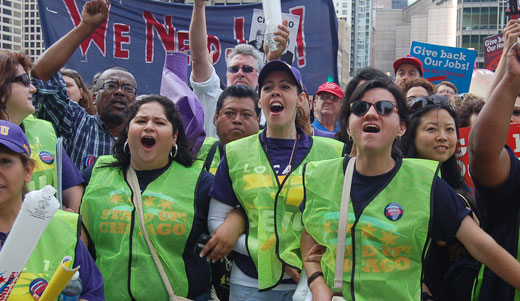
It took women on the job all of 2012 and every day of 2013 up until April 9 to earn the eqivalent that men earned in 2012 alone.
In other words, on Equal Pay Day 2013 yesterday, a woman worker’s median wage was only 77 cents for every dollar of a man’s with the same qualifications and background. The findings were in a study done by the National Partnership for Women and Families (NPWF).
In a special proclamation yesterday, President Obama said that “too many Americans are seeing their hard work go unrewarded because of circumstances beyond their control, Women – who make up nearly half of our nation’s workforce – face a pay gap that means they earn 23 percent less on average than men do. That disparity is even greater for African-American women and Latinas.
“Wage inequality undermines the promise of fairness and opportunity upon which our country was founded,” the president said, adding, “For families trying to make ends meet, that gap can also mean the difference between falling behind and getting ahead.”
The president’s proclamation said thatgrowing the middle class in the future requires closing of the pay gap. “And to back our belief in equality with the weight of law, I continue to call on Congress to pass the Paycheck Fairness Act,” the president said.
Republican filibusters have killed equal pay bills every time that have come up in the Senate.
The 77 cents per dollar ratio is bad, the NPWF says, but data for African-American and Latina women are, as the president noted in his proclamation, even worse. The African-American women’s median pay translated to 64 cents for every dollar their white male equivalent colleagues earned. For Latinas, it was 55 cents per dollar. Those two gaps have been closing “at a rate of less than half a cent a year since the Equal Pay Act” of 1963, the NPWF said.
The NPWF said national median yearly pay for women employed full-time – the point where half the nation’s women are above it and half below – is $37,118. That’s $11,084 less than the median for men ($48,202).
“It is terribly disappointing that not a single state or metropolitan area has eliminated the wage gap that punishes women and their families. This illustrates how pervasive the gender-based wage gap is, and what it costs families,” said Debra Ness, president of the NPWF. “With most women serving as essential breadwinners for their families, the loss of this critical income has devastating consequences. Lawmakers should make ending gender discrimination in pay and promotions a much higher priority.”
In some states – including Vermont and Texas – the median wage gap is smaller than the national chasm because both men and women are below the national median pay figures. That’s how Vermont finishes with the second-smallest gap among the states. Its female ($38,177) and male ($44,057) workers earn below the national median. Texas has the 10th-smallest gap, as both groups are several thousand dollars per worker per year below Vermont.
The study used Census Bureau data on incomes for male and female workers. The Census Bureau broke down its figures by states, while NPWF extended its study to metro areas, Latino women and African-American women.
But a separate survey, by the Bureau of Labor Statistics earlier this year, shows one real equalizer in pay between men and women is the union contract. BLS reported median weekly – not yearly — earnings figure for all workers nationwide was $768 last year. For unionists, the median was $933, and for non-union workers, it was $742.
The median income for union men last year was $997, compared to an $877 median figure for union women. That’s 88 percent of the median union man’s weekly pay, and far above the medians for non-union men ($821) and non-union women ($663).
“Fifty years ago this year, the Equal Pay Act became law. Yet a punishing wage gap persists for women in every corner of the country,” Ness added. “We must do more to close the wage gap, which is present in every industry, and affects workers with every level of education.”
Mark Gruenberg of Press Associates contributed to this story.
Photo: Female workers demonstrate for equal pay. PW










